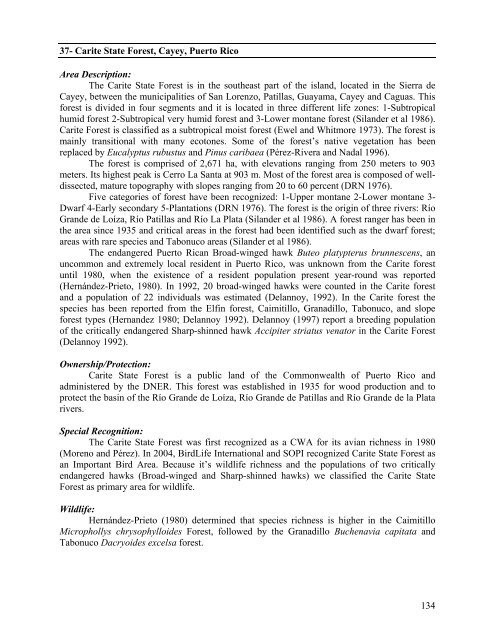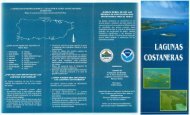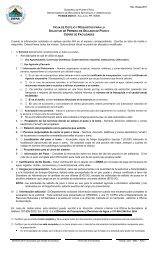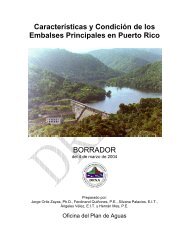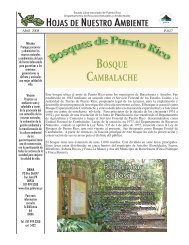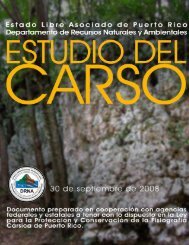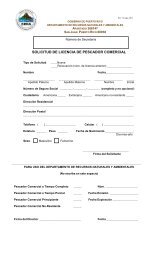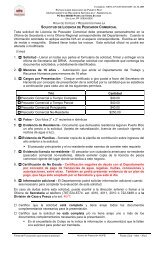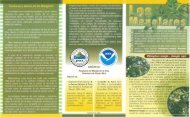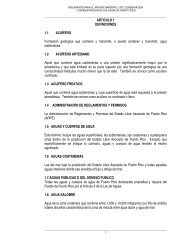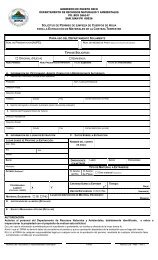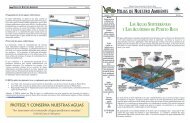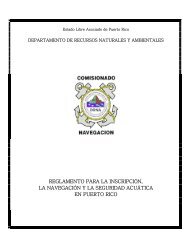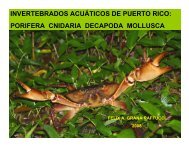Puerto Rico Critical Wildlife Areas - Puerto DRNA - Gobierno de ...
Puerto Rico Critical Wildlife Areas - Puerto DRNA - Gobierno de ...
Puerto Rico Critical Wildlife Areas - Puerto DRNA - Gobierno de ...
Create successful ePaper yourself
Turn your PDF publications into a flip-book with our unique Google optimized e-Paper software.
37- Carite State Forest, Cayey, <strong>Puerto</strong> <strong>Rico</strong><br />
Area Description:<br />
The Carite State Forest is in the southeast part of the island, located in the Sierra <strong>de</strong><br />
Cayey, between the municipalities of San Lorenzo, Patillas, Guayama, Cayey and Caguas. This<br />
forest is divi<strong>de</strong>d in four segments and it is located in three different life zones: 1-Subtropical<br />
humid forest 2-Subtropical very humid forest and 3-Lower montane forest (Silan<strong>de</strong>r et al 1986).<br />
Carite Forest is classified as a subtropical moist forest (Ewel and Whitmore 1973). The forest is<br />
mainly transitional with many ecotones. Some of the forest’s native vegetation has been<br />
replaced by Eucalyptus rubustus and Pinus caribaea (Pérez-Rivera and Nadal 1996).<br />
The forest is comprised of 2,671 ha, with elevations ranging from 250 meters to 903<br />
meters. Its highest peak is Cerro La Santa at 903 m. Most of the forest area is composed of welldissected,<br />
mature topography with slopes ranging from 20 to 60 percent (DRN 1976).<br />
Five categories of forest have been recognized: 1-Upper montane 2-Lower montane 3-<br />
Dwarf 4-Early secondary 5-Plantations (DRN 1976). The forest is the origin of three rivers: Río<br />
Gran<strong>de</strong> <strong>de</strong> Loíza, Río Patillas and Río La Plata (Silan<strong>de</strong>r et al 1986). A forest ranger has been in<br />
the area since 1935 and critical areas in the forest had been i<strong>de</strong>ntified such as the dwarf forest;<br />
areas with rare species and Tabonuco areas (Silan<strong>de</strong>r et al 1986).<br />
The endangered <strong>Puerto</strong> Rican Broad-winged hawk Buteo platypterus brunnescens, an<br />
uncommon and extremely local resi<strong>de</strong>nt in <strong>Puerto</strong> <strong>Rico</strong>, was unknown from the Carite forest<br />
until 1980, when the existence of a resi<strong>de</strong>nt population present year-round was reported<br />
(Hernán<strong>de</strong>z-Prieto, 1980). In 1992, 20 broad-winged hawks were counted in the Carite forest<br />
and a population of 22 individuals was estimated (Delannoy, 1992). In the Carite forest the<br />
species has been reported from the Elfin forest, Caimitillo, Granadillo, Tabonuco, and slope<br />
forest types (Hernan<strong>de</strong>z 1980; Delannoy 1992). Delannoy (1997) report a breeding population<br />
of the critically endangered Sharp-shinned hawk Accipiter striatus venator in the Carite Forest<br />
(Delannoy 1992).<br />
Ownership/Protection:<br />
Carite State Forest is a public land of the Commonwealth of <strong>Puerto</strong> <strong>Rico</strong> and<br />
administered by the DNER. This forest was established in 1935 for wood production and to<br />
protect the basin of the Río Gran<strong>de</strong> <strong>de</strong> Loíza, Río Gran<strong>de</strong> <strong>de</strong> Patillas and Río Gran<strong>de</strong> <strong>de</strong> la Plata<br />
rivers.<br />
Special Recognition:<br />
The Carite State Forest was first recognized as a CWA for its avian richness in 1980<br />
(Moreno and Pérez). In 2004, BirdLife International and SOPI recognized Carite State Forest as<br />
an Important Bird Area. Because it’s wildlife richness and the populations of two critically<br />
endangered hawks (Broad-winged and Sharp-shinned hawks) we classified the Carite State<br />
Forest as primary area for wildlife.<br />
<strong>Wildlife</strong>:<br />
Hernán<strong>de</strong>z-Prieto (1980) <strong>de</strong>termined that species richness is higher in the Caimitillo<br />
Microphollys chrysophylloi<strong>de</strong>s Forest, followed by the Granadillo Buchenavia capitata and<br />
Tabonuco Dacryoi<strong>de</strong>s excelsa forest.<br />
134


